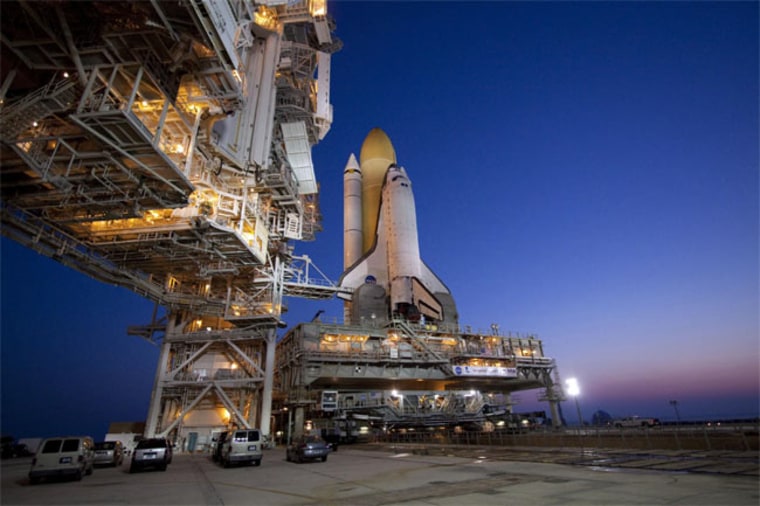Skywatchers across the continental United States will get a fine opportunity this weekend to watch as the space shuttle Atlantis — on its final scheduled mission into space — chases and ultimately docks with the International Space Station.
Both the shuttle and space station will be visible as separate entities, each appearing as bright "stars" sailing across the evening twilight sky on Friday and Saturday. By Sunday evening, Atlantis will be docked to the space station, and both will appear as a single bright moving "star."
To reach the space station, Atlantis must be launched when Earth's rotation carries the launch pad at NASA's Kennedy Space Center in Florida into the plane of the station's orbit.
For the upcoming STS-132 mission, this will happen in the middle of a 10-minute launch window at 2:19:59 p.m. ET on Friday. Atlantis will track to the northeast, roughly parallel to the U.S. East Coast. About 25 minutes later, the space station, which will be moving along a similar southwest-to-northeast path, will be passing over northern Florida.
The space station makes one full circuit of the Earth in approximately 91.5 minutes. Initially, Atlantis will be situated about 67 minutes behind the space station, but over the 44 hours following its Friday afternoon liftoff, Atlantis will gradually close that gap, ultimately docking with the space station at 10:27 a.m. ET on Sunday.
During Friday, Saturday and Sunday evenings, both Atlantis and the space station will make a number of favorable passes across the contiguous U.S. Their respective ground tracks will take them on northwest-to-southeast paths. With few exceptions, between one and four crossings of both the shuttle and the space station will be visible.
How bright?
Most satellites become visible only when they are in sunlight and the observer is in deep twilight or darkness. This usually means shortly after dusk or before dawn.
Because of its size and configuration of highly reflective solar panels, the space station is now, by far, the brightest human-made object currently in Earth orbit. On favorable passes, it's as brilliant as magnitude -5 in brightness, which would rival even the planet Venus, and outshines Sirius, the brightest star in the night sky some 25-fold.
Some have even caught a glimpse of the space station in the daytime just prior to sunset or shortly after sunrise. And as a bonus, sunlight glinting directly off the solar panels can sometimes make the space station appear to briefly flare to super-brilliance.
The space shuttle also appears as a very bright (magnitude 0 to -1) object, almost matching Sirius, though nowhere near as dazzling as the space station.
In February both shuttle Endeavour and the space station could be viewed flying closely in tandem with one another across the sky, but that will not be possible with these upcoming evening crossings of Atlantis and the space station: Both will appear too widely separated on Friday and Saturday evenings.
Region of visibility
Generally speaking, Atlantis and the space station will be visible across parts of southern Canada and most of the 48 continental United States.
Many locations will be favored with as many as three or four viewing opportunities. In contrast, Hawaii and Alaska will not have any viewing opportunities, nor will there be any views in Canada roughly north of latitude 50 degrees.
Over the southernmost United States, the viewing opportunities will be reduced to just one or none at all.
Some localities will be favored with exceptionally good passes. On Friday evening, the space station will appear to soar to a point virtually overhead as seen from Toronto (9:10 p.m. ET) and New York (9:11 p.m. ET).
A similarly high overflight of the space station will be visible from Chicago on Saturday evening (8:33 p.m. CT), and the two docked spacecraft will pass almost directly over Flagstaff, Ariz., on Sunday evening (8:30 p.m. MT).
When and where to look
So what is the viewing schedule for your particular hometown? You can easily find out by searching for one of these four popular Web sites: Chris Peat's Heavens Above, Science@NASA's J-Pass, NASA's SkyWatch and Spaceweather.com.
Each will ask for your zip code or city, and respond with a list of suggested spotting times. Predictions computed a few days ahead of time are usually accurate within a few minutes. However, they can change due to the slow decay of the space station's orbit and periodic reboosts to higher altitudes. Check frequently for updates.
Another great site is this one, which provides real-time satellite tracking and shows what part of the Earth the space station or shuttle happens to be passing over at any given time.
